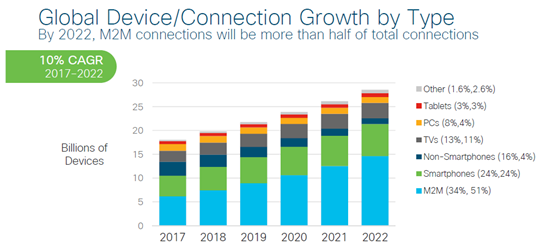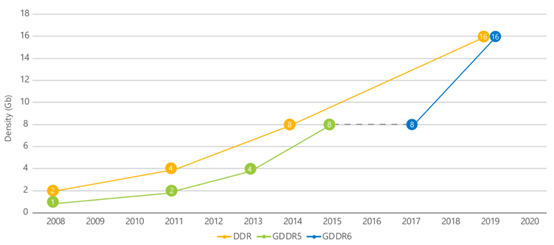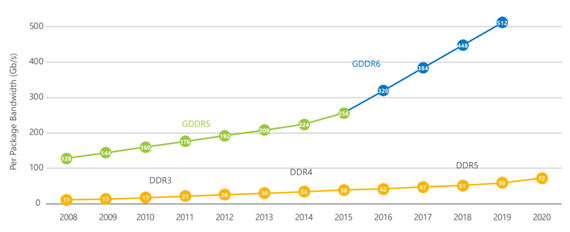As network and data center bandwidth requirements increase, so does the need for high-performance memory solutions. For system development beyond 400 Gbps, achieving the performance and efficiency of the memory scheme in a cost-effective manner has become one of the key challenges in the project.
Graphics Double Data Rate (GDDR) memory was originally developed to meet the high-performance graphics computing needs of game consoles and PCs. Other areas, such as networking and data centers, provide products with low-risk, flexible, and cost-effective memory solutions.
In the following chapters, this article will first share the networking industry macro trends driving these high bandwidth and high performance needs, then discuss how GDDR6 meets these needs better than any other high bandwidth memory solution today, and finally introduce the Achronix Speedster7t GDDR6 controllers in FPGA products.
We will continue to publish a series of articles on other useful knowledge of GDDR6, such as GDDR6 architecture and basic usage, performance evaluation of access bandwidth and latency, network application reference design, and how to deal with signal integrity challenges in GDDR6 system-level design, stay tuned.
2. Network Industry Trends
Cisco’s 2019 Visual Networking Index report[1]According to the report, the monthly average of global Internet IP traffic in 2017 was 122 EB (1018 Bytes), and it is expected to increase to 396 EB by 2022, with a compound annual growth rate (CAGR) of 26%. related to growing video traffic.

Figure 1: Global Internet IP Traffic Forecast (Cisco VNI 2017-2022)[1]
the same study[1]It is predicted that the number of connected devices such as smartphones and tablets will grow from 18 billion in 2017 to more than 28.5 billion in 2022 (Figure 2), when the number of network access devices per capita will reach 3.6 . Thanks to the development of 5G and the Internet of Things (IoT), the number of M2M devices in the total number of connected nodes will exceed 50% in 2022.

Figure 2: Network devices that need to be connected (Cisco VNI 2017-2022)[1]
3. What is driving network demand?
Growth in several important areas is driving these unprecedented demands in the networking industry:
• Mobile data and Internet video: There is an increasing demand for on-demand access to data and high-definition video over the Internet. (Non-demand network access is not included here, such as DDoS attacks that occupy more than 25% of the entire network traffic)
• Internet of Things (IoT): The Internet of Things is increasing the number of devices that must access the network, such as wearables, smart appliances, and cars.
? Cloud services: Countless companies are migrating their services to the cloud, and innovation in the cloud is increasing.
? Big data analytics: For all parts of a complex network to function efficiently, edge devices in the network must use intelligent data analytics to better and faster understand the data they carry.
In short, more users, more devices, bigger screens, and more diverse cloud services are driving exponential growth in IP traffic. How can we design products to meet these requirements when growth shows no sign of slowing down?
4. Why use GDDR6?
Reason 1: Great Performance
Today, the density of GDDR6 has reached 16Gbits, which is consistent with the highest capacity DDR4 memory chips. The bandwidth of GDDR6 devices is up to 512Gb/s, which is 10 times that of DDR4. In the future, GDDR6 will evolve to higher capacity and faster speeds in accordance with the standard. These advantages of GDDR6 make it ideal for meeting the demands of modern networking.

Figure 3: DDR vs. GDDR capacity comparison [2]

Figure 4: DDR vs. GDDR bandwidth comparison[2]
Reason 2: Lower Total Cost of Ownership
When considering total cost of ownership (TCO), be sure to consider all aspects of the design. Figure 5 compares three different approaches to meet the needs of 1Tb switching applications. As shown, using GDDR6 not only reduces design complexity by 80%, but also reduces PCB area by 82% and increases energy efficiency by 44% relative to DDR4.

Figure 5: Comparison of total cost of ownership (TCO) for various mainstream memory solutions[2]
Reason 3: Easy Design
If you are already familiar with traditional DDR design, designing with GDDR memory will be a familiar, low-risk experience. For logic engineers and software engineers, GDDR6 is similar to the approach used by traditional DDR technology, and the GDDR6 controller built into Speedster7t FPGAs further simplifies design. For hardware engineers, the design rules of the high-speed single-ended SerDes signal pins of GDDR6 and the low-speed signal pins of DDR are quite different. Achronix will provide high-speed signal design manuals and reference designs to help customers migrate from DDR to GDDR6 with low risk. .
If you are already familiar with GDDR5 design, the transition to GDDR6 will be a very smooth design experience. The main differences between GDDR6 and GDDR5 relate to package and pinout, following the same design practices.
5. GDDR6 controller in Achronix Speedster7t FPGA products
Achronix semiconductor‘s Speedster7t FPGA family is optimized for high-bandwidth workloads, eliminating the performance bottlenecks associated with traditional FPGAs. Based on TSMC’s 7nm FinFET process technology, the Speedster7t FPGA features a revolutionary new 2D Network-on-Chip (NoC) and an ingenious Machine Learning Processor (MLP) matrix, and leverages IP such as a high-bandwidth GDDR6 interface, 400G Ethernet, and PCI Express Gen5 ports , which provides ASIC-level performance while retaining full programming performance.
Figure 6: Achronix Speedster7t1500 High-Performance FPGA Architecture[3]
The Speedster7t FPGA is designed with up to 8 GDDR6 controllers to provide the fastest access speeds at a lower cost while maintaining low power consumption equivalent to LPDDR5 levels. Each GDDR6 controller supports up to 32 bits of data for a total of 4Tbps of memory bandwidth. The GDDR6 controller and PHY are hard IP without consuming programmable logic resources in the FPGA and without facing the timing closure challenges of place and route. Together, these characteristics make the GDDR6 SDRAM interface an excellent choice for next-generation system designs.
The Links: G185XW01-V2 SKIIP30NAB12T49 LCDDISPLAY

0 Comments for “Extending the benefits of GDDR6 from graphics computing to high-performance networking applications”